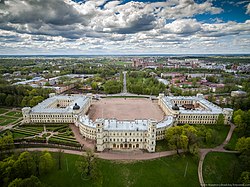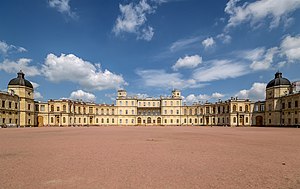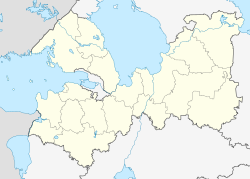Gatchina
Gatchina
Гатчина | |
|---|---|
 Aerial view of theGatchina Palace | |
| Coordinates:59°35′N30°08′E/ 59.583°N 30.133°E | |
| Country | Russia |
| Federal subject | Leningrad Oblast[1] |
| Administrative district | Gatchinsky District[1] |
| Settlement municipal formation | Gatchinskoye Settlement Municipal Formation[1] |
| First mentioned | 1499[2] |
| Town status since | 1796[2] |
| Elevation | 100 m (300 ft) |
| Population | |
| • Total | 92,937 |
| • Rank | 184thin 2010 |
| •Capitalof | Gatchinsky District,[1]Gatchinskoye Settlement Municipal Formation[1] |
| •Municipal district | Gatchinsky Municipal District[4] |
| •Urban settlement | Gatchinskoye Urban Settlement[4] |
| •Capitalof | Gatchinsky Municipal District,[5]Gatchinskoye Urban Settlement[4] |
| Time zone | UTC+3(MSK |
| Postal code(s)[7] | 188300-188310, 188319, 188399 |
| Dialing code(s) | +7 81371[8] |
| OKTMOID | 41618101001 |
| Town Day | Third Saturday in September[9] |
| Website | www |
Gatchina(‹See Tfd›Russian:Га́тчина,IPA:[ˈɡatːɕɪnə]) is atownand theadministrative centerofGatchinsky DistrictinLeningrad Oblast,Russia.It lies 45 kilometers (28 mi) south-south-west ofSt. Petersburg,along theE95highway which links Saint Petersburg andPskov.Population:92,937 (2010 Census);[3]88,420 (2002 Census);[10]79,714 (1989 Soviet census).[11]
| Year | Pop. | ±% |
|---|---|---|
| 1897 | 14,824 | — |
| 1926 | 16,600 | +12.0% |
| 1939 | 38,201 | +130.1% |
| 1959 | 36,725 | −3.9% |
| 1970 | 63,292 | +72.3% |
| 1979 | 75,153 | +18.7% |
| 1989 | 79,714 | +6.1% |
| 2002 | 88,420 | +10.9% |
| 2010 | 92,937 | +5.1% |
| 2021 | 94,377 | +1.5% |
| Source: Census data | ||
It was previously known asKhotchino,[2]Gatchina(until February 14, 1923),[12]Trotsk(until August 2, 1929),[13]andKrasnogvardeysk(until January 28, 1944).[13]
Gatchina, the largest town in Leningrad Oblast, is best known as the location of theGreat Gatchina Palace,one of the main residences of theRussian Imperial Familyduring the 18th and 19th centuries. The historic center and Gatchina Palace are part of theUNESCOWorld Heritage Site's "Historic Centre of Saint Petersburg and Related Groups of Monuments".[14] Another popular tourist attraction in Gatchina is thePrioratsky Palace.
Gatchina has placed highly inquality-of-liferankings in Russia.[citation needed]
History
[edit]Early history
[edit]Gatchina was first documented in 1499 under the nameKhotchinoas a village in possession of theNovgorod Republic.[2]In the 17th century it was passed toLivoniaand then toSwedenin a series of wars, until the early years of theGreat Northern Warat the turn of the 1700s when the area was returned toRussia.[2]In 1703, Gatchina found itself in the southern vicinity of the new Russian capital,Saint Petersburg,which was being constructed 45 kilometers (28 mi) north at themouthof theNeva River.Despite technically still belonging toSwedish Ingria,in 1708, Gatchina was given byPeter the Greatto his sister,Natalya Alexeyevna,and after her death in 1716 Peter founded an Imperial Hospital and Apothecary there.[15]In 1765, it became the property ofCount Orlov.[2]
Imperial residence
[edit]18th century
[edit]
In 1765,Catherine the Great,Empress of theRussian Empire,purchased Gatchina Manor from PrinceBoris Kurakin,which featured the village and a smallmanor.Gatchina was gifted by Catherine to one of her favorites, CountGrigory Grigoryevich Orlov,who reportedly organized theassassination of Tsar Peter IIIthree years earlier, resulting in her becoming empress. Between 1766 and 1788, Count Orlov built the massiveGreat Gatchina Palacein place of the original manor, with 600 rooms, an extensive English landscape park over 7 square kilometers (2.7 sq mi), with an adjacentzooand a horse farm.[16]Atriumphal archwas erected to a design by the architect of Gatchina Palace,Antonio Rinaldi,forming a monumental entrance. Upon Orlov's death in 1783, Gatchina Palace was bought by Catherine from his heirs, and gave it to her son Grand DukePavel Petrovich,the future Tsar Paul I.[2]During his ownership, Paul made alterations to the palace, but also began developing the village of Gatchina into a town using experience from his travels aroundEurope.After ascending to the throne, Paul granted Gatchina the status of Imperial City, an honorary designation for towns that possessed aroyal palace.Gatchina Palace was expanded and altered numerous times by its subsequent imperial owners, with the addition ofRococointeriors designed by Rinaldi andVincenzo Brenna,and executed byItalianstucco workersand Russian craftsmen.[17]
19th century
[edit]In 1854, arailroadconnecting Gatchina and Saint Petersburg was opened, and the territory of Gatchina was expanded with several villages in the vicinity beingincorporatedinto the city.[18]The following year Gatchina Palace came under the ownership ofTsar Alexander II,who used it as his second residence. Alexander built a hunting village south of Gatchina into a retreat where he and his guests could enjoy the unspoiled wilderness of northwestern Russia. Following theassassination of Alexander IIin 1881, Gatchina Palace was passed to his shaken son, the newTsar Alexander III,who was advised that he and his family would be safer in Gatchina as opposed to at theWinter Palacein Saint Petersburg. Alexander spent most of his life at Gatchina Palace, which became known as "The Citadel ofAutocracy"after the Tsar's reactionary policies. Here he signed decrees, held diplomatic receptions, theatrical performances,masqueradesand costumed balls, and other events and entertainment. Alexander III introduced some technologicalmodernizationsnew to Russia at the Gatchina Palace, such as indoorheaters,electric lights,atelephonenetwork, non-freezing water pipes and a modernsewagesystem. His son, the futureTsar Nicholas IIand the last Russian Tsar, spent his youth in the Gatchina Palace, although he and his family would makeTsarskoye Selohis home. His mother,Dowager Empress Maria Feodorovna,widow of Alexander III, was the patron of the city of Gatchina, the palace and its parks.
20th century
[edit]Gatchina was honored as the best-kept city of Russia at the1900 World's FairinParis(Exposition Universelle). The quality of life, education, medical services, and public safety in Gatchina were recognized as the best, and it was recommended as an example for other cities in Russia. In 1910, one of the firstairfieldsin Russia was established in Gatchina, with the city becoming one of the first centers of aviation and engine technology in Russia.[2]The pilotPyotr Nesterovwas trained at the Gatchina airfield and made his first long-distance flight from Gatchina toKiev.Gatchina Palace remained one of the official imperial residences of Tsar Nicholas II, who was presiding over annualmilitary paradesand celebrations of theImperial Russian Armygarrisons, stationed in Gatchina until 1917.
DuringWorld War I,major medical hospitals in Gatchina were visited by the Tsar Nicholas II and Empress Maria Fyodorovna, the mother of Nicholas II, his wife the EmpressAlexandra Fyodorovna,as well as their daughtersGrand Duchess Olga,Grand Duchess Tatiana,Grand Duchess Maria,andGrand Duchess Anastasia.
In March 1917, the Russian Empire collapsed upon theabdication of Nicholas IIfollowing theFebruary Revolution,leading to a decline in Gatchina's importance as the town and its palace becamestate propertyof the RussianProvisional Government,who converted it to amuseum.
Shortly afterwards, theBolsheviksseized power in theOctober Revolutionand the outbreak of theRussian Civil Warfollowed. It saw Gatchina loyal to theWhite Movement,and the palace was visited by PresidentAlexander Kerenskyof the deposedRussian Provisional Governmenton October 27, 1917. During Kerensky's visit, fighting broke out in Gatchina between detachments of theRed GuardsandCossackunits of GeneralPyotr Krasnov.The Reds won the battle, which had avoided the palace, and on November 1, they held a rally outside the palace in the main square, wherePavel Dybenkoencouraged the Cossack units stationed in the palace to surrender and not to oppose the Red authorities. Kerensky left Gatchina Palace that night, and it was occupied by Red troops the following day.[19]
In May 1918, the museum was re-opened by the Reds "for the victorious popular masses of the Russian Revolution" in Gatchina.[20]From 1918 to 1941, the Gatchina Palace and parks were open to public as a national museum. On February 14, 1923, Gatchina was renamedTrotsk(‹See Tfd›Russian:Троцк) by the new Soviet authorities, afterLeon Trotsky.[12]AfterJoseph Stalinbecame General Secretary of theRussian Communist Party (b),Trotsky was graduallyexiled(and later killed on Stalin's orders), and the town was renamedKrasnogvardeysk(Красногварде́йск,Red Guard City) on August 2, 1929.[13]

Gatchina was occupied byNazi Germanyfrom Saturday, September 13, 1941, following theGerman invasion of RussiaduringWorld War II. The Germans renamed the townLindemannstadt,in honor of theWehrmachtgeneralGeorg Lindemann,and looted much of the Gatchina Palace for its collections of art. On January 26, 1944, the Germans abandoned Lindemannstadt during their retreat, setting fire to Gatchina Palace andvandalizingmuch of the park. The town was quickly retaken by theRed Army,and two days later it was renamed back to its original pre-Soviet name, Gatchina.[21][13]
Rebuilding
[edit]After the war, Gatchina was rebuilt to Soviet standards, and became home to the Petersburg Institute of Nuclear Physics. The extent of the Gatchina Palace's devastation was extraordinary, and initially was considered irreparable damage. Restoration works continued for over 60 years, and some pieces of the art collection were recovered from safe keeping and returned to Gatchina. Today, one section of the Gatchina Palace is partially completed and certain state rooms and the Arsenal Halls are now open to the public. Other areas of the palace, including those of Tsar Alexander III, remain closed and unrestored.
In 1990, shortly before thedissolution of the Soviet Union,Gatchina Palace and surviving buildings in Gatchina's historic center becameUNESCOWorld Heritage Sites,as part of the widerSaint Petersburg and Related Groups of Monuments.[22]In 1999, Gatchina was awarded in the Most Comfortable City of Russia, aquality of lifecompetition for Russian towns and cities, being ranked first in Category III, the category for cities with a population of under 100,000. In 2010, Gatchina's status as anHistorical city of Russiawas revoked.
Name
[edit]The town has notably been known under various names during its history. As common with larger urban areas under theSoviet Union,Gatchina was renamed to reflect the changed ideals of the government. This first came in honouring Leon Trotsky. However, with the feud between Trotsky and Stalin at a high this name was to become problematic. Thus, the city was renamed again in honour of the Soviet troops. Unlike other regions that underwent this process, Gatchina has a more complex history leading to multiple variations.
| Name | Period | Named For | Governing Power |
|---|---|---|---|
| Khotchino | 1499–1700s | Lust for authority or noble status | Novgorod Republic Livonia |
| 1700s–1917 | |||
| 1917 | Provisional Government Whites | ||
| 1917–1923 | |||
| Trotsk | 1923–1929 | Leon Trotsky | |
| Krasnogvardeysk | 1929–1941 | "Red Guard"City | |
| Lindemannstadt | 1941–1944 | Georg Lindemann | |
| Gatchina | 1944– | Variant spelling of historic "Khotchino" |
Administrative and municipal divisions
[edit]Within theframework of administrative divisions,Gatchina serves as theadministrative centerofGatchinsky District.[1]As an administrative division, it is incorporated within Gatchinsky District asGatchinskoyeSettlement Municipal Formation.[1]As amunicipal division,Gatchinskoye Settlement Municipal Formation is incorporated within Gatchinsky Municipal District asGatchinskoye Urban Settlement.[4]
Economy
[edit]Industry
[edit]In Gatchina, there are several enterprises related to timber industry, including a paper mill, and to food industry.[23]
Transportation
[edit]
Gatchina is an important railway node. One railway, running north to south, connects theBaltiysky railway stationin St. Petersburg withDnoandNevel.Within the town limits, suburban trains in this direction stop at the platform ofTatyaninoand the station ofGatchina-Varshavskaya.Another railway, also from the Baltiysky railway station, arrives to Gatchina from the northwest and has two stops,MariyenburgandGatchina-Passazhirskaya-Baltiyskaya.Yet another railway runs south of the town center from east to west and connectsMgaviaUlyanovkawithVolosovo.The railway station on this line in Gatchina isGatchina-Tovarnaya-Baltiyskaya.
TheM20 Highwayconnecting St. Petersburg andPskov,crosses Gatchina from north to south. South of Gatchina, it crosses the A120 Highway, which encircles St. Petersburg. A paved road connects Gatchina withKingiseppvia Volosovo. There are also local roads.

Science
[edit]Gatchina is the site of thePetersburg Nuclear Physics Institute.[24]
Twin towns – sister cities
[edit]Gatchina istwinnedwith:[25][26][27][28]
 Eskilstuna,Sweden
Eskilstuna,Sweden Ettlingen,Germany
Ettlingen,Germany Coatbridge,United Kingdom
Coatbridge,United Kingdom Chișinău,Moldova
Chișinău,Moldova
References
[edit]Notes
[edit]- ^abcdefghOblast Law #32-oz
- ^abcdefghЭнциклопедия Города России.Moscow: Большая Российская Энциклопедия. 2003. p. 104.ISBN5-7107-7399-9.
- ^abRussian Federal State Statistics Service (2011).Всероссийская перепись населения 2010 года. Том 1[2010 All-Russian Population Census, vol. 1].Всероссийская перепись населения 2010 года [2010 All-Russia Population Census](in Russian).Federal State Statistics Service.
- ^abcdLaw #115-oz
- ^Law #113-oz
- ^"Об исчислении времени".Официальный интернет-портал правовой информации(in Russian). June 3, 2011.RetrievedJanuary 19,2019.
- ^Почта России. Информационно-вычислительный центр ОАСУ РПО. (Russian Post).Поиск объектов почтовой связи(Postal Objects Search)(in Russian)
- ^Гатчина и Гатчинский район Справочная информация(in Russian). gatchina.biz.RetrievedFebruary 27,2014.
- ^Гатчина готовится к Дню города(in Russian). Администрация МО «Город Гатчина».RetrievedFebruary 27,2014.
- ^Federal State Statistics Service(May 21, 2004).Численность населения России, субъектов Российской Федерации в составе федеральных округов, районов, городских поселений, сельских населённых пунктов – районных центров и сельских населённых пунктов с населением 3 тысячи и более человек[Population of Russia, Its Federal Districts, Federal Subjects, Districts, Urban Localities, Rural Localities—Administrative Centers, and Rural Localities with Population of Over 3,000](XLS).Всероссийская перепись населения 2002 года [All-Russia Population Census of 2002](in Russian).
- ^Всесоюзная перепись населения 1989 г. Численность наличного населения союзных и автономных республик, автономных областей и округов, краёв, областей, районов, городских поселений и сёл-райцентров[All Union Population Census of 1989: Present Population of Union and Autonomous Republics, Autonomous Oblasts and Okrugs, Krais, Oblasts, Districts, Urban Settlements, and Villages Serving as District Administrative Centers].Всесоюзная перепись населения 1989 года [All-Union Population Census of 1989](in Russian). Институт демографии Национального исследовательского университета: Высшая школа экономики [Institute of Demography at the National Research University: Higher School of Economics]. 1989 – viaDemoscope Weekly.
- ^abГатчинский уезд (февраль 1923 г. - август 1927 г.)(in Russian). Система классификаторов исполнительных органов государственной власти Санкт-Петербурга. Archived fromthe originalon March 4, 2016.RetrievedFebruary 27,2014.
- ^abcdТроцкий район (август 1927 г. - август 1929 г.), Красногвардейский район (август 1929 г. - январь 1944 г.), Гатчинский район (январь 1944 г.)(in Russian). Система классификаторов исполнительных органов государственной власти Санкт-Петербурга. Archived fromthe originalon December 3, 2013.RetrievedFebruary 27,2014.
- ^ UNESCO World Heritage Centre."Historic Centre of Saint Petersburg and Related Groups of Monuments".unesco.org.RetrievedNovember 6,2015.
- ^Peter the Great: His Life and World(Knopf, 1980) by Robert K. Massie,ISBN0-394-50032-6(also Wings Books, 1991,ISBN0-517-06483-9)
- ^photo
- ^St. Petersburg: Architecture of the Tsars.Abbeville Press, 1996.ISBN0-7892-0217-4
- ^Suburbs of St.Petersburg: GatchinaArchived17 March 2008 at theWayback Machine
- ^Alexander Kerensky,The Catastrophe(New York, 1927)
- ^(in Russian)Гатчинский дворец, годы испытаний
- ^Max Schafer (2011),Jahrgang 1924,p. 44ISBN3-8423-1113-3
- ^UNESCO World Heritage Centre."Historic Centre of Saint Petersburg and Related Groups of Monuments".unesco.org.RetrievedNovember 6,2015.
- ^Комитет экономики и инвестиций(in Russian). Гатчинский муниципальный район.RetrievedFebruary 7,2013.
- ^"Petersburg Nuclear Physics Institute. National Research Centre" Kurchatov Institute "".pnpi.spb.ru.Archived fromthe originalon November 4, 2015.RetrievedNovember 6,2015.
- ^"Побратимы Гатчины и Гатчинского района".radm.gtn.ru(in Russian). Gatchinsky District.RetrievedFebruary 3,2020.
- ^"Verkostot".espoo.fi(in Finnish). Espoo. Archived fromthe originalon December 17, 2018.RetrievedFebruary 3,2020.
- ^"MINUTE OF MEETING OF COATBRIDGE AREA COMMITTEE"(PDF).North Lanarkshire Council. 23 June 1998. Archived fromthe original(PDF)on 5 March 2012.Retrieved8 January2009.
- ^"Гатчина и Кишинев установили побратимские связи"(in Russian). Gatchina Council.
Sources
[edit]- Законодательное собрание Ленинградской области. Областной закон №32-оз от 15 июня 2010 г. «Об административно-территориальном устройстве Ленинградской области и порядке его изменения», в ред. Областного закона №23-оз от 8 мая 2014 г. «Об объединении муниципальных образований "Приморское городское поселение" Выборгского района Ленинградской области и "Глебычевское сельское поселение" Выборгского района Ленинградской области и о внесении изменений в отдельные Областные законы». Вступил в силу со дня официального опубликования. Опубликован: "Вести", №112, 23 июня 2010 г.(Legislative Assembly of Leningrad Oblast. Oblast Law #32-oz of June 15, 2010On the Administrative-Territorial Structure of Leningrad Oblast and on the Procedures for Its Change,as amended by the Oblast Law #23-oz of May 8, 2014On Merging the Municipal Formations of "Primorskoye Urban Settlement" in Vyborgsky District of Leningrad Oblast and "Glebychevskoye Rural Settlement" in Vyborgsky District of Leningrad Oblast and on Amending Various Oblast Laws.Effective as of the day of the official publication.).
- Законодательное собрание Ленинградской области. Областной закон №113-оз от 16 декабря 2004 г. «Об установлении границ и наделении соответствующим статусом муниципального образования Гатчинский муниципальный район и муниципальных образований в его составе», в ред. Областного закона №17-оз от 6 мая 2010 г «О внесении изменений в некоторые областные законы в связи с принятием федерального закона "О внесении изменений в отдельные законодательные акты Российской Федерации в связи с совершенствованием организации местного самоуправления" ». Вступил в силу через 10 дней со дня официального опубликования (27 декабря 2004 г.). Опубликован: "Вести", №147, 17 декабря 2004 г.(Legislative Assembly of Leningrad Oblast. Oblast Law #113-oz of December 16, 2004On Establishing the Borders of and Granting an Appropriate Status to the Municipal Formation of Gatchinsky Municipal District and to the Municipal Formations It Comprises,as amended by the Oblast Law #17-oz of May 6, 2010On Amending Various Oblast Laws Due to the Adoption of the Federal Law "On Amending Various Legislative Acts of the Russian Federation Due to the Improvement of the Organization of the Local Self-Government".Effective as of after 10 days from the day of the official publication (December 27, 2004).).
- Законодательное собрание Ленинградской области. Областной закон №115-оз от 22 декабря 2004 г. «Об установлении границ и наделении статусом городского поселения муниципального образования город Гатчина в Гатчинском муниципальном районе», в ред. Областного закона №43-оз от 27 июня 2013 г. «О присоединении деревни Большая Загвоздка к городу Гатчина и о внесении изменений в некоторые Областные законы в сфере административно-территориального устройства Ленинградской области». Вступил в силу через 10 дней со дня официального опубликования (2 января 2005 г.). Опубликован: "Вести", №149, 23 декабря 2004 г.(Legislative Assembly of Leningrad Oblast. Oblast Law #115-oz of December 22, 2004On Establishing the Borders of and Granting Urban Settlement Status to the Municipal Formation of the Town of Gatchina in Gatchinsky Municipal District,as amended by the Oblast Law #43-oz of June 27, 2013On Merging the Village of Bolshaya Zagvozdka into the Town of Gatchina and on Amending Various Oblast Laws on the Subject of the Administrative-Territorial Structure of Leningrad Oblast.Effective as of after 10 days from the day of the official publication (January 2, 2005).).
Further reading
[edit]- St. Petersburg: Architecture of the Tsars.Abbeville Press, 1996.ISBN0789202174
- Knopf Guide: St. Petersburg.New York: Knopf, 1995.ISBN0-679-76202-7
- Glantz, David M.The Battle for Leningrad, 1941–1944.Lawrence: University Press of Kansas, 2002.ISBN0-7006-1208-4
- Radzinsky, Edvard.Alexander II: The Last Great Tsar.New York: The Free Press, 2005.ISBN0-7432-7332-X







